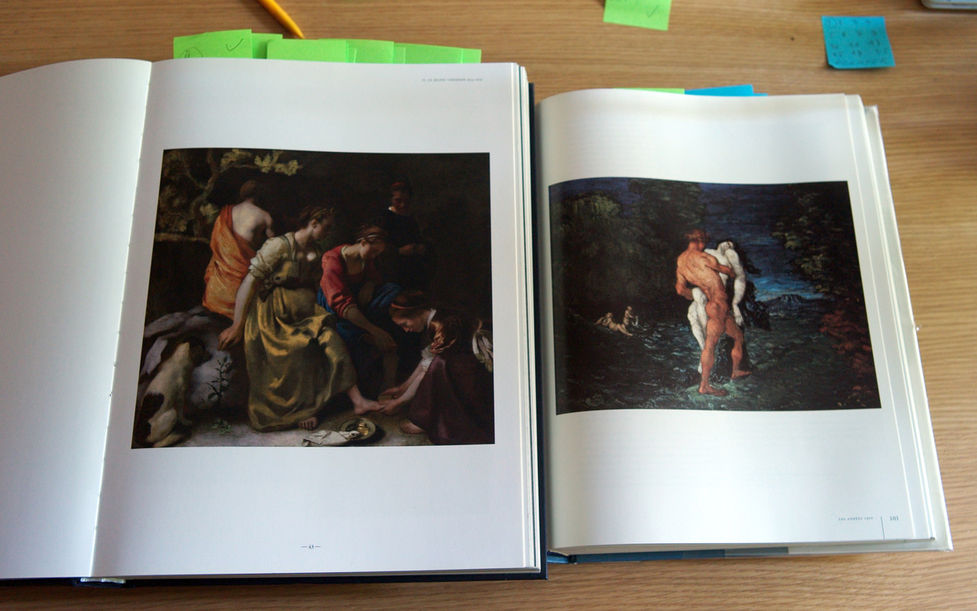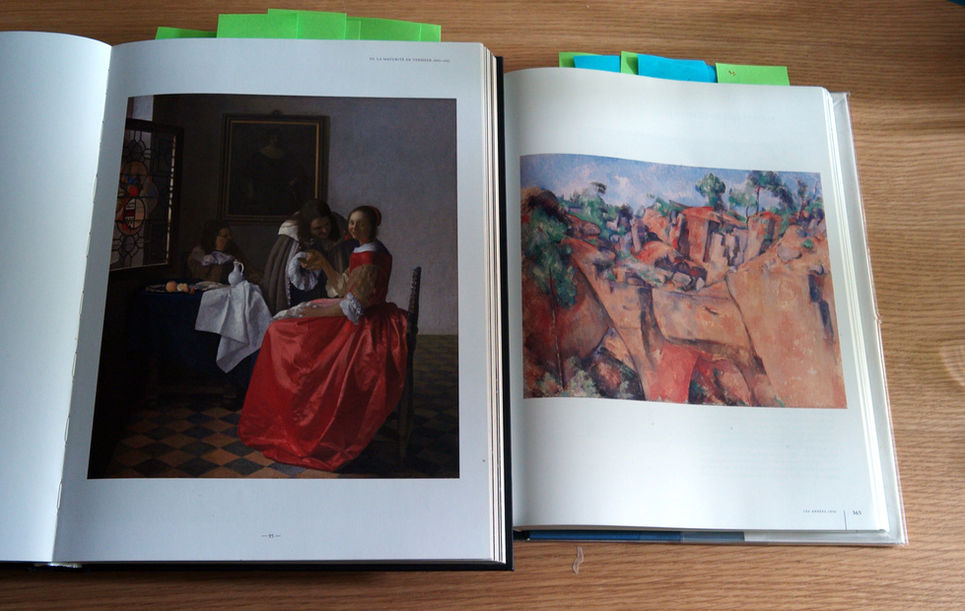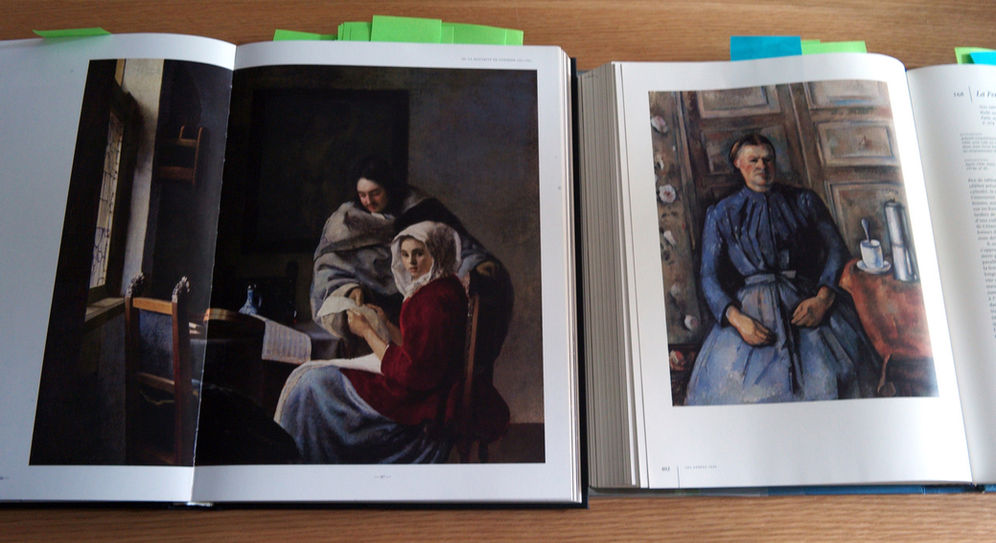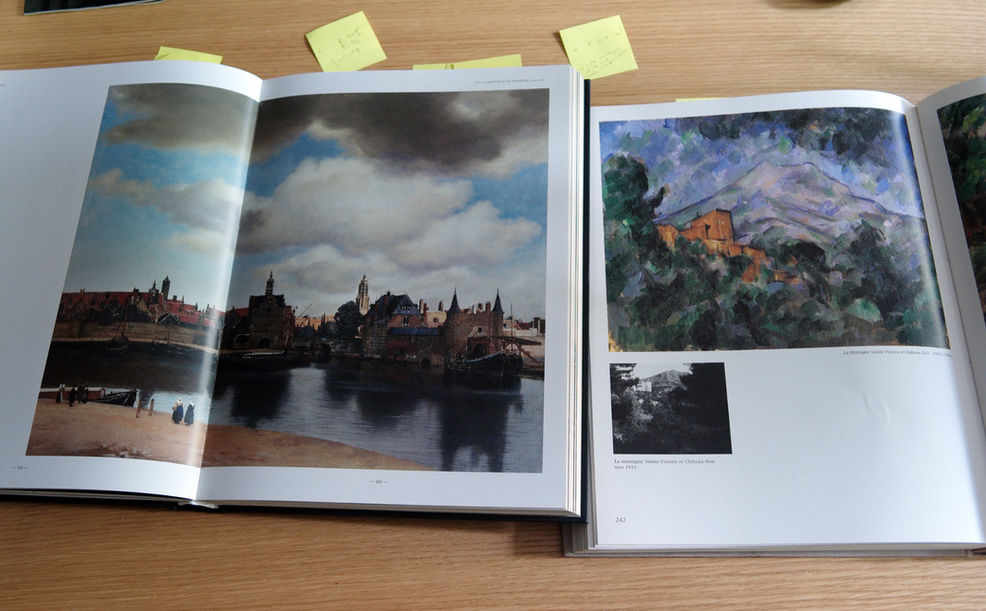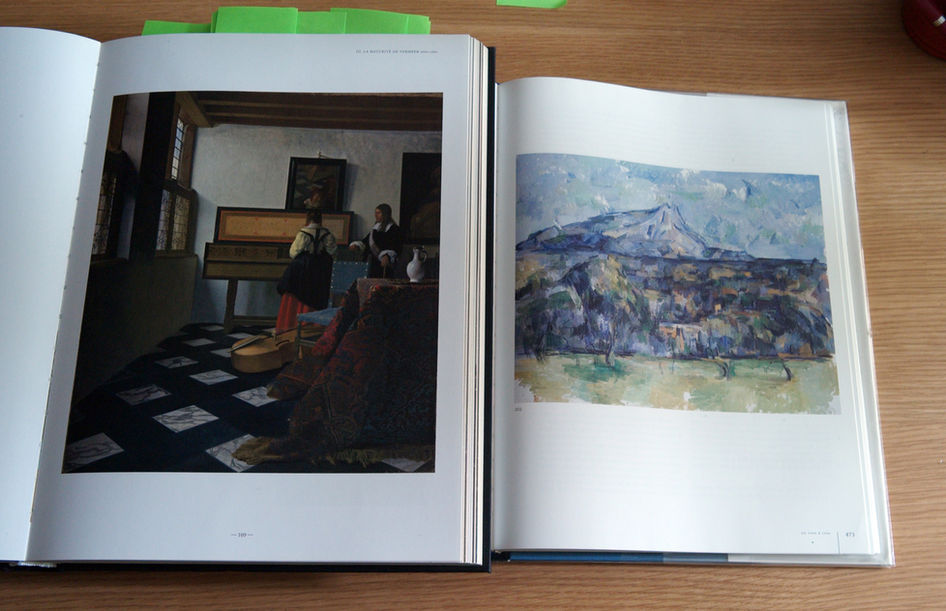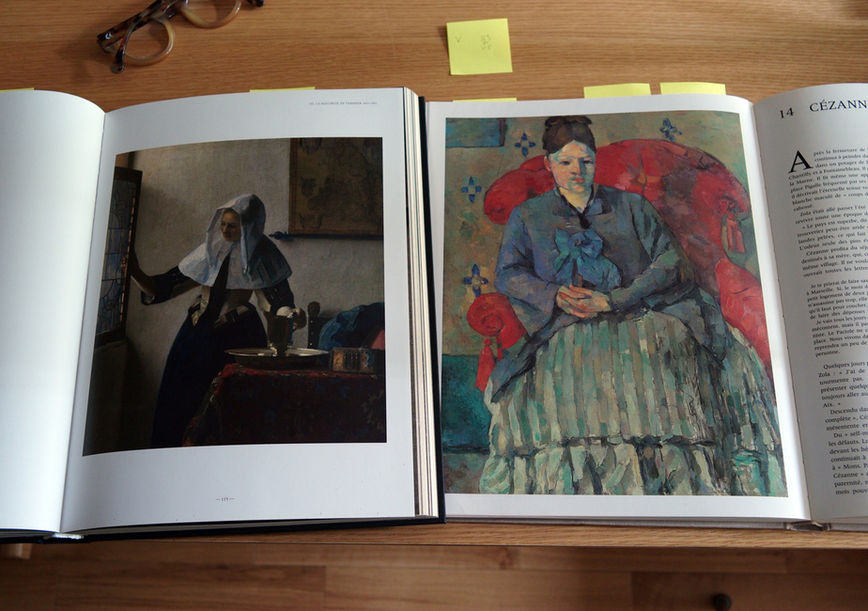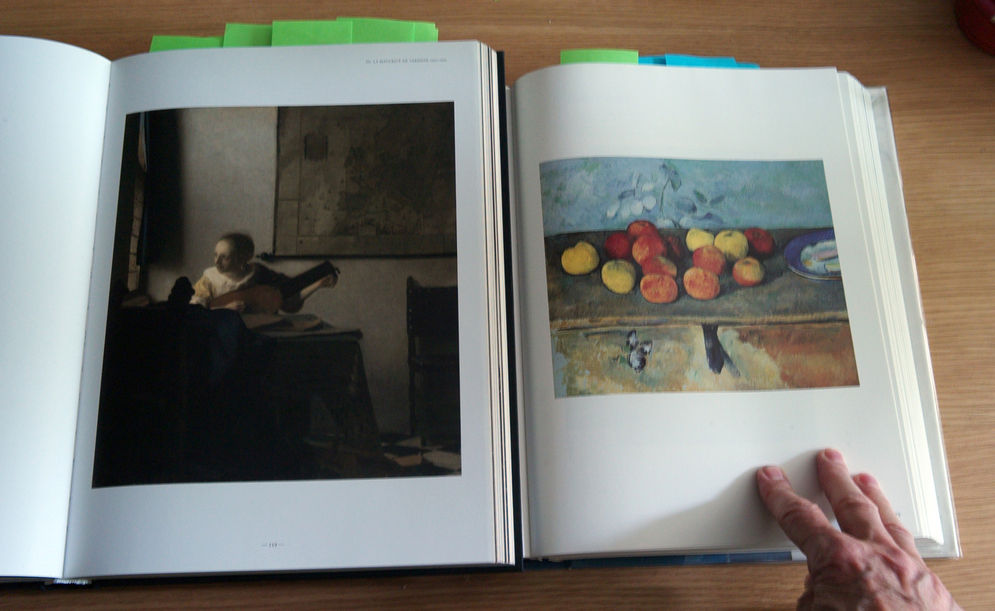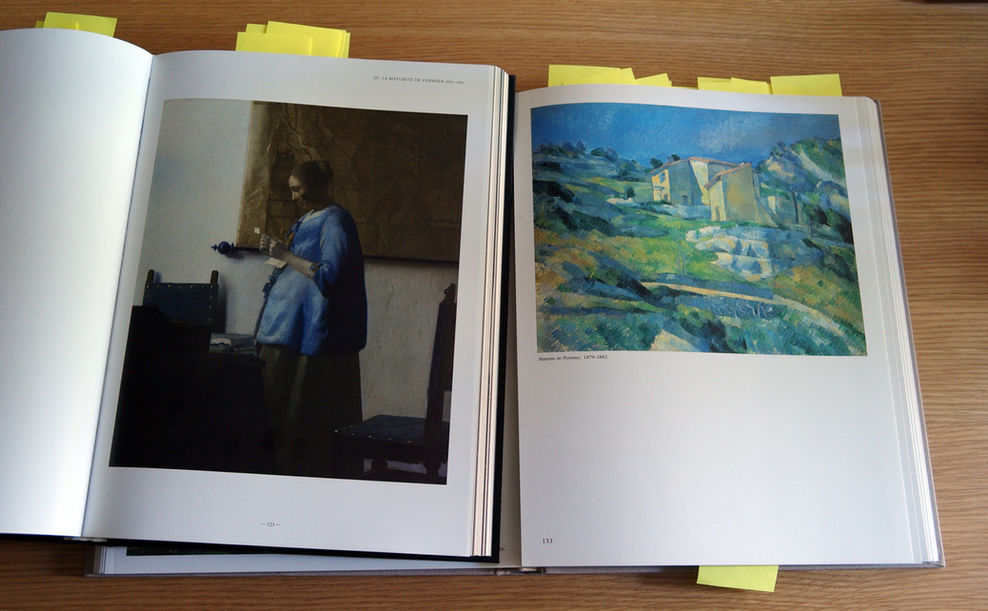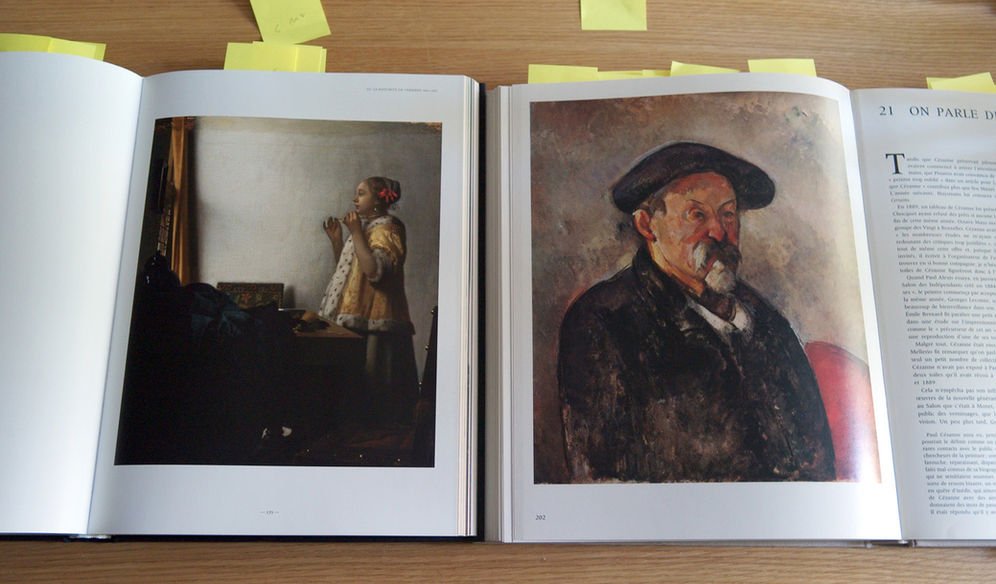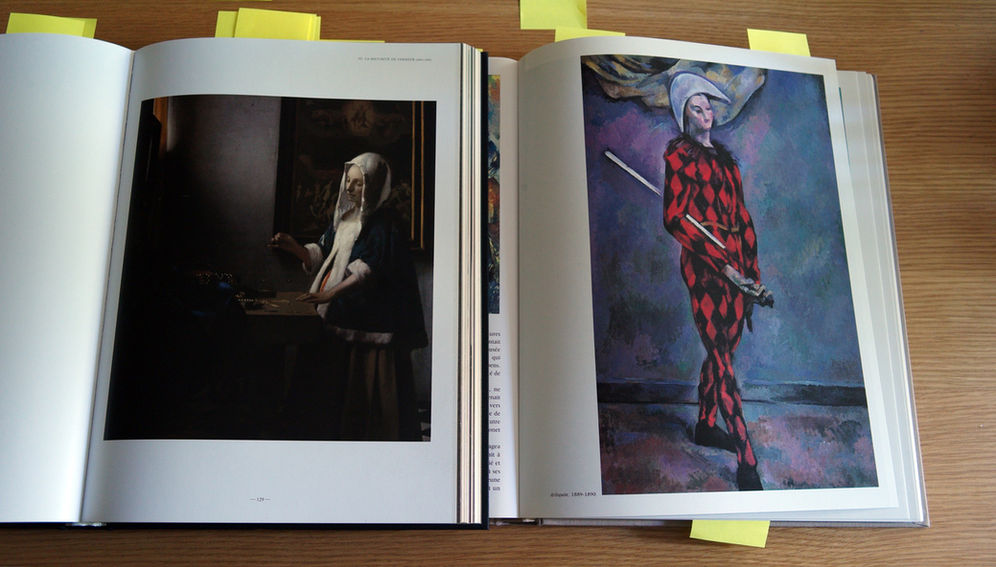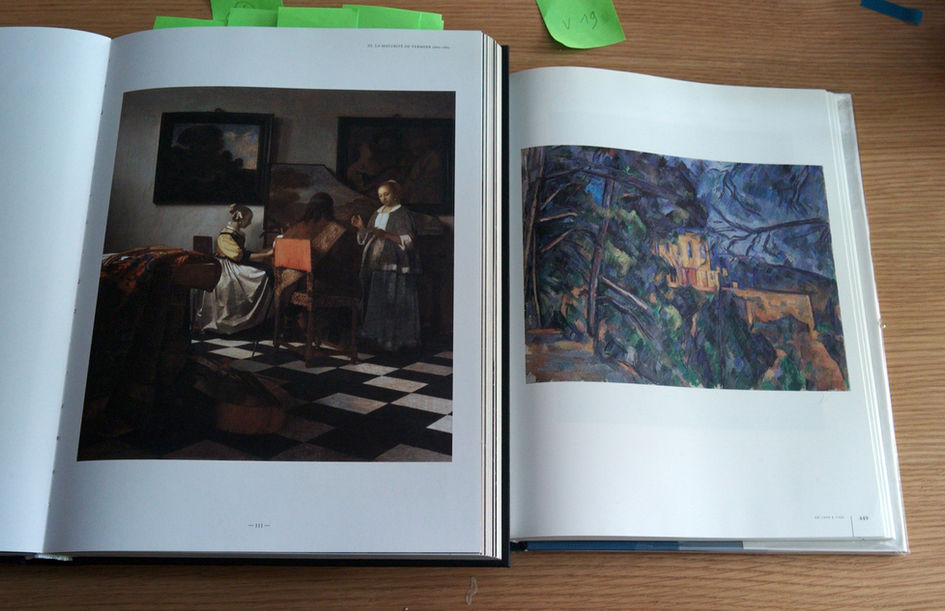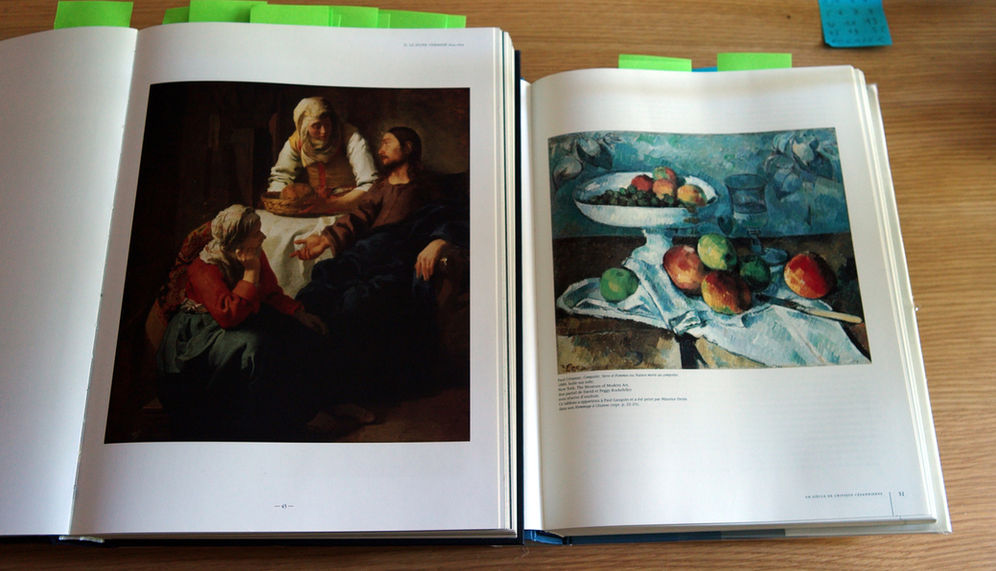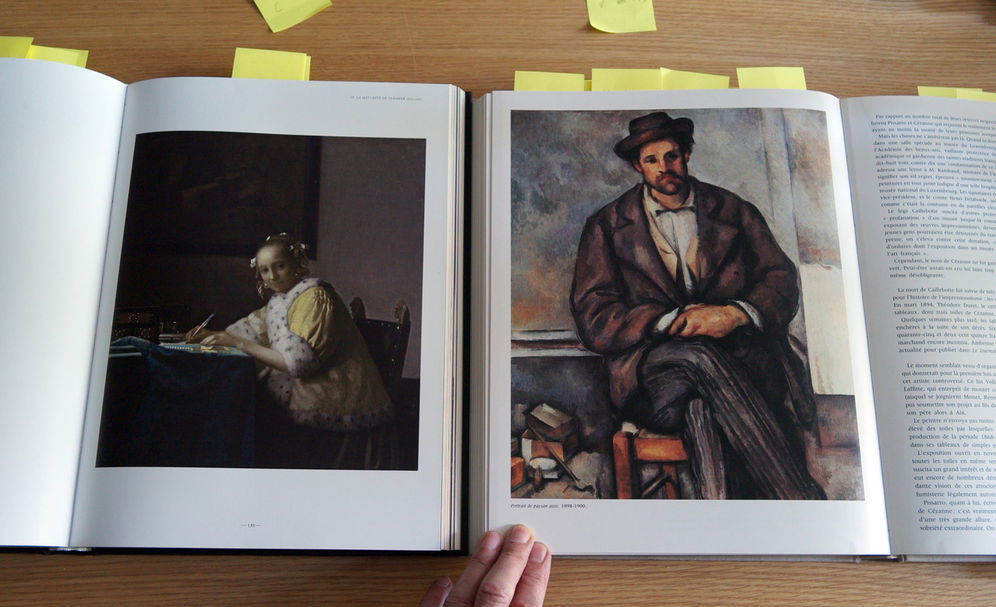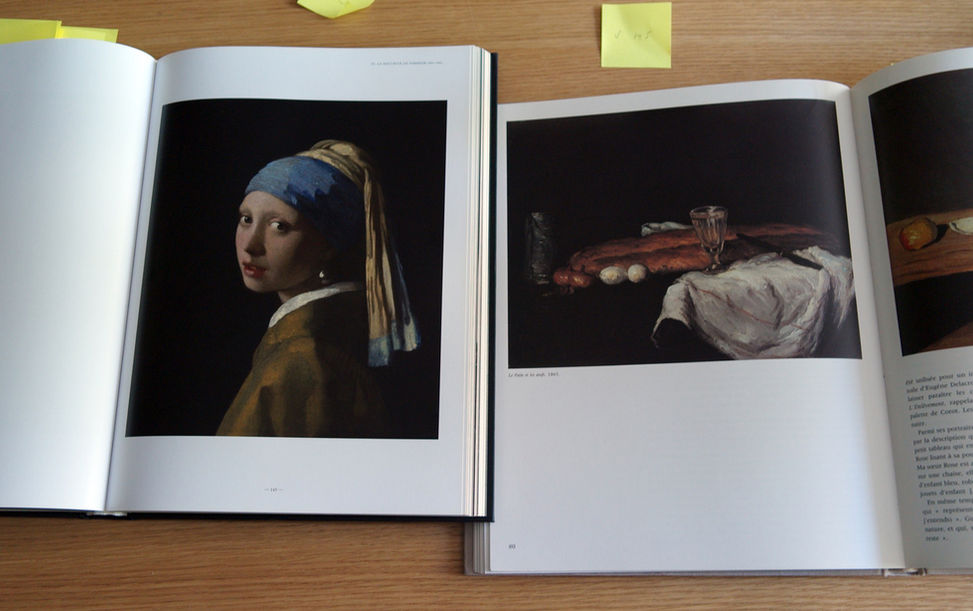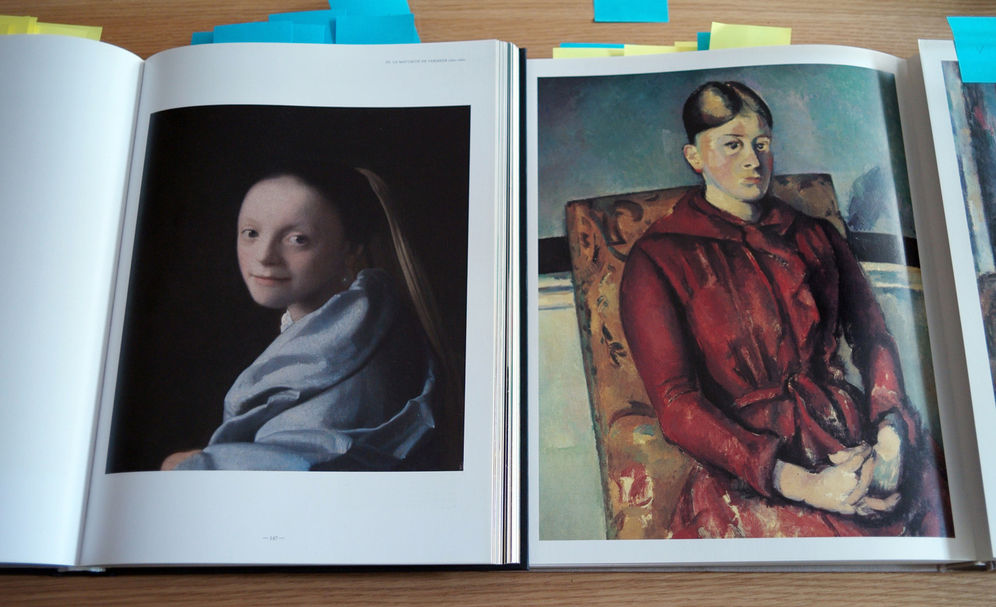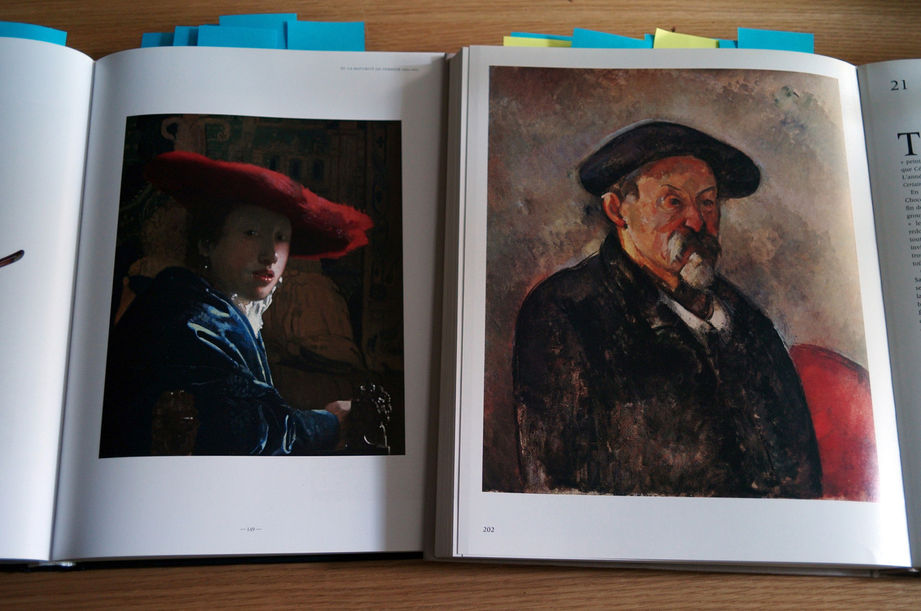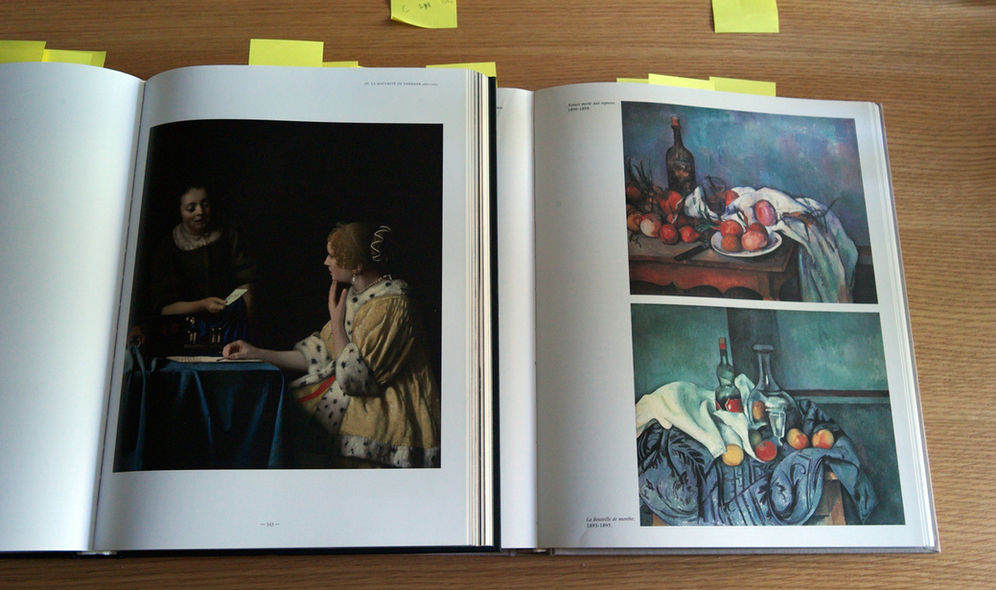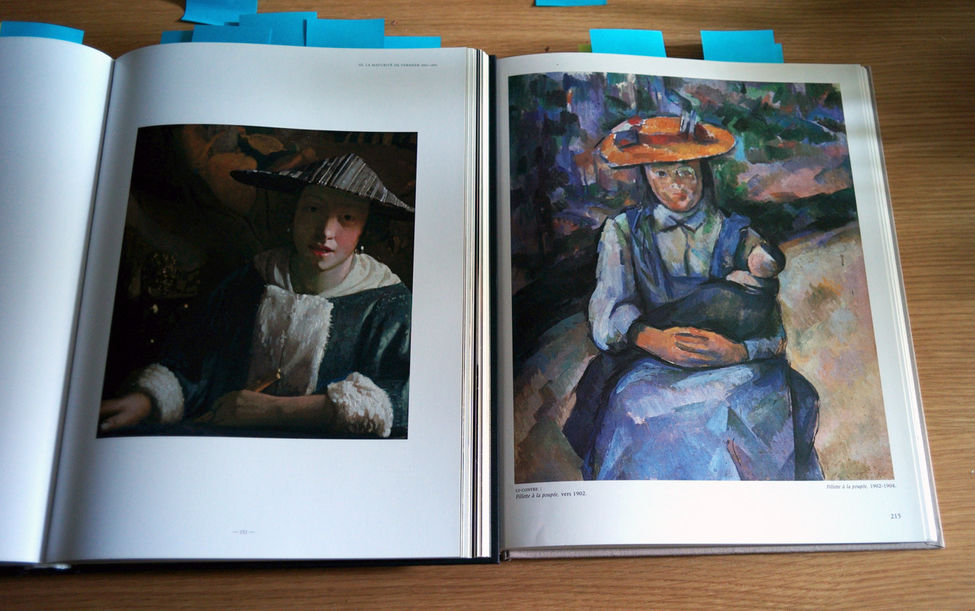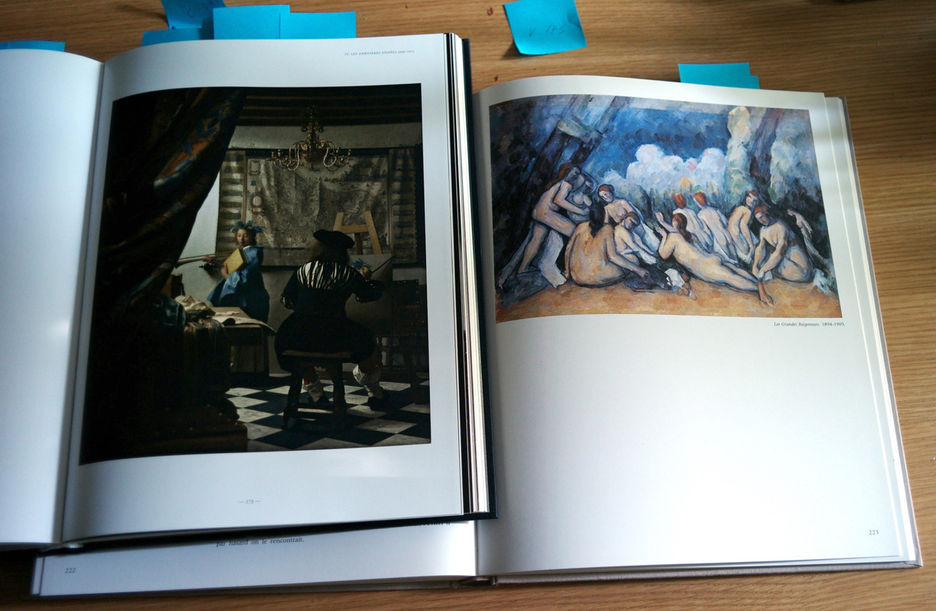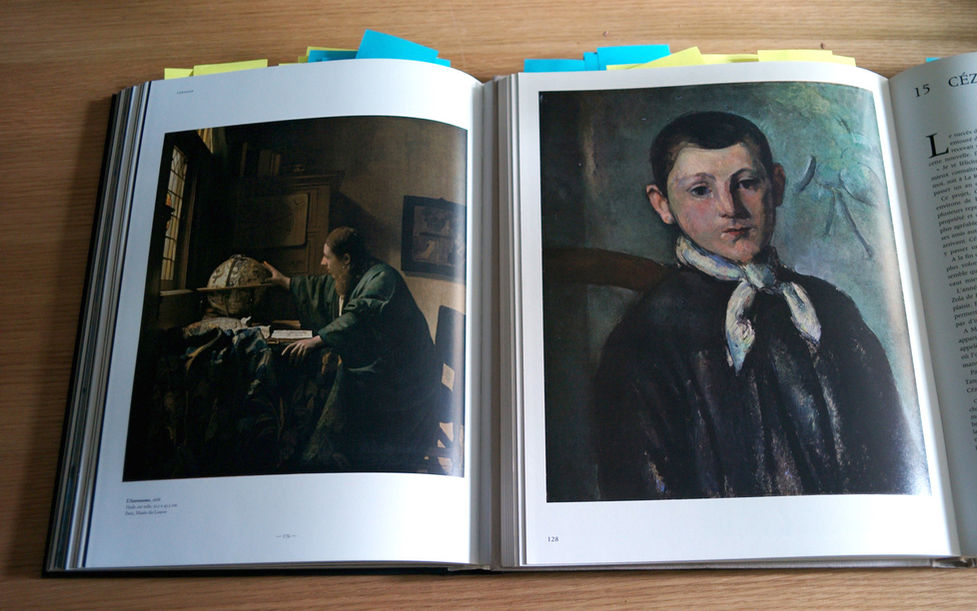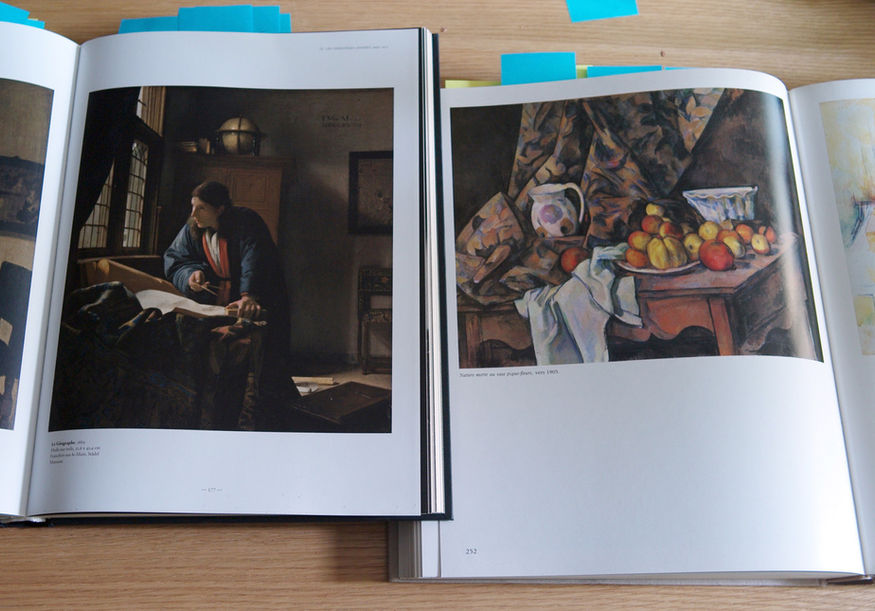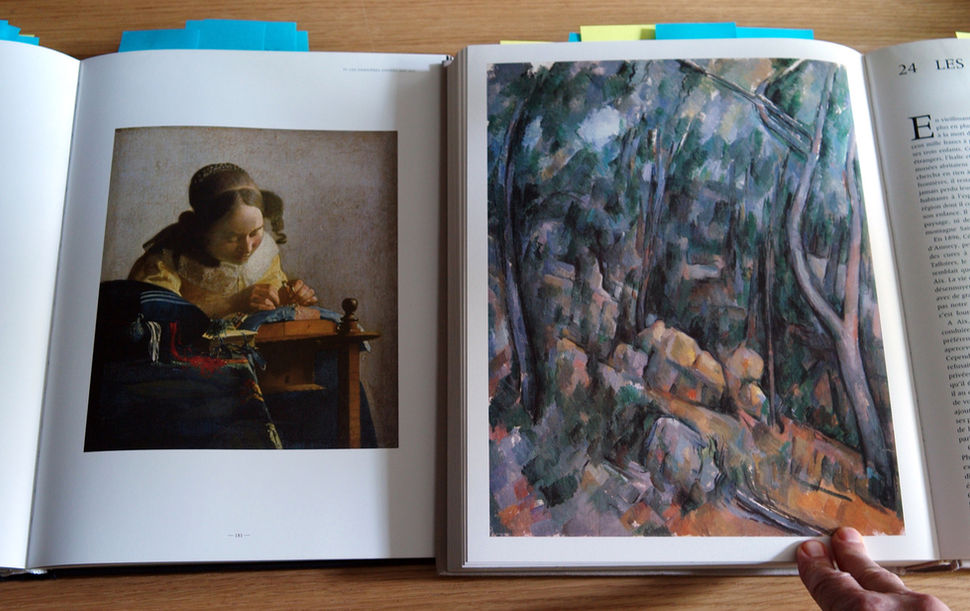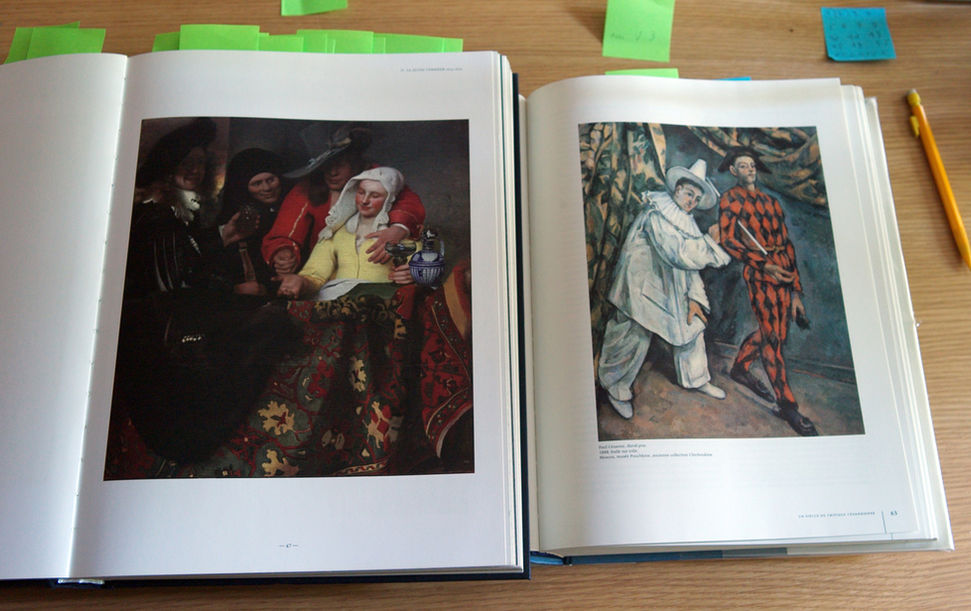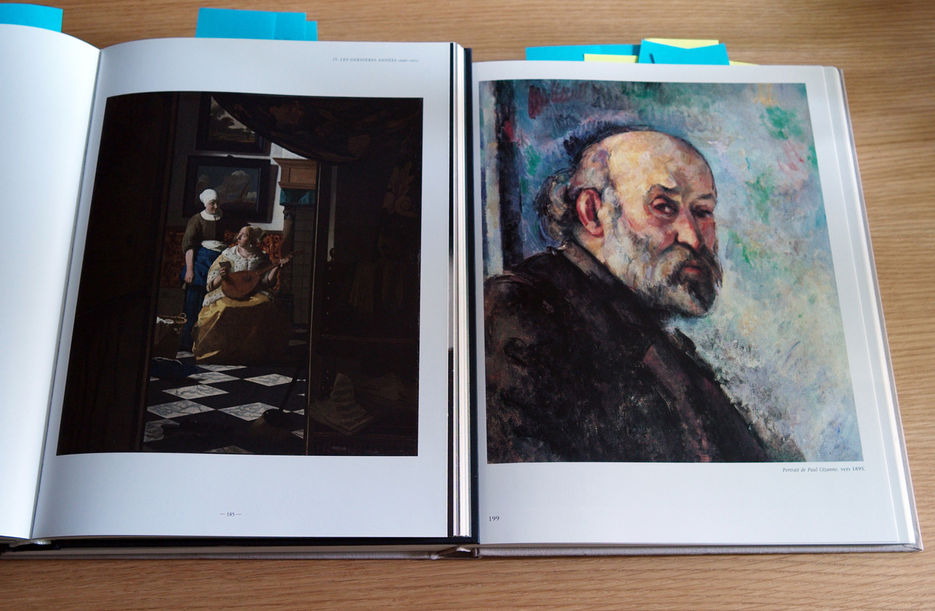All Cézanne's of Vermeer | Cem İleri
Sarkis has a rather straightforward premise in Vermeer–Cézanne: He picks a painting each from a Vermeer and a Cézanne catalogue, opens those two pages side by side, and captures the image together with post-its sticking out of other pages, his hand holding the page, and the surface of the table. What you see are thirty-five photographs, all taken using the same method at Sarkis's desk at home. It's an associative automaton; a gesture in seeing and showing where there are no unique pieces to show, nor a live audience to view the exhibition. This reminds me of Tarkovsky’s The Sacrifice, and its character Alexander perusing an album of Russian icons in one of the early scenes. I put these two albums, catalogues, images side by side, look again, and they are nearly identical. That's how the mind of Sarkis must work then: it matches, juxtaposes, processes all the time. It also refers to his "Genesis": Sarkis was inspired to become an artist when he saw Munch's Scream on a sheet of magazine they used as wrapping paper in his father's butcher shop. Second-hand art history, learned vicariously through books, poor impressions and reproductions, aroused a different way of seeing and instilled another understanding of distance in him. He is drawn to the innumerable stages between the original and the copy; he skips across the painting, the painting's reproduction, the reproduction's photograph, the photograph's sketch, the reflection of the sketch on water... The position changes constantly, and so does the image. As it has now: What I am looking at is exactly the digital image of the photograph of the reproduction –made for the book– of the photograph of the painting.
Merely by the virtue of the medium he chooses, Sarkis helps the two paintings start to talk to us before we start comparing them like it is expected of us; before we flick our gaze from one to another, trying to find similarities, relations and kinship among the two artists; even before we get to questions like why Sarkis has chosen Vermeer and Cézanne to juxtapose. They are images that have become copies of the copy; they have lost their original state, distance, scale, color and frame; they were re-produced. It is as if Sarkis is putting into action the well-known words of Barthes that he liked to use often, in different texts and varying contexts. Aggrandization as a way of reading immediately invokes its opposite, reduction, and illustrates how images can be transformed or activated by mental means. In “Réquichot and His Body”: “Yet there is often in one and the same painting the whole history of art (it suffices to change the scale of perception: Nicolas de Staël is in 3 square centimeters of Cézanne." In How to Live Together: “Detail: Cézanne / De Staël. If you scale up a detail from a painting, a picture, you get a new picture. It was said (as I have repeated often) that the whole of Nicolas de Staël has come out of five square centimeters of Cézanne.” All the paintings we see here, even those that were small to begin with, were reduced in size and pushed into five or ten square centimeters of Cézanne. They are now other paintings; the scale of perception has changed. It is as if Sarkis wants us to look at "the act of looking at pictures", and not the pictures themselves. He desires us to settle in his mind and eye, re-produce his gaze, and trace as the things he sees in one skip across to the other. There is another inversion going on: The premise of Sarkis is the entire works of Vermeer; a portfolio of thirty-five paintings, an entire opus. Instead of looking at Cézanne and choosing Vermeer, Sarkis looks at Vermeer and chooses or makes one choose Cézanne; he reverses chronology and retraces two hundred years of difference, noting the reflections of Vermeer’s works in a bath of light on Cézanne, from where he traces rays towards himself. I look at the Vermeer Collection of Sarkis. I feel like I have been invited into a home and am now stealing a glance at the notes that my host left open on the desk; I try to see like Didi-Huberman discovering Jackson Pollock’s “drip” technique in Fra Angelico's frescoes in the Convent of San Marco, like Vermeer, like Cézanne, like Sarkis. Of course I notice convergence, transposition, superposition, nuances, signs, seminal narratives, jokes, tension, anachronism, leaps––who wouldn't? But I can't express or write these; all I can do is to keep moving about for a long time in this tiniest of spaces where colors and shapes watch each other on the surface.

Vermeer and Cézanne catalogues that Sarkis used
Vermeer-Cézanne
MAMCO, Genève, May-June 2020
photos: Julien Grémaud
SARKİS | NORGUNK
EXHIBITION
”Mayakovsky-Lissitsky: The Source Illuminates”, 21.11.2019 – 18.01.2020, Riverrun, Bunker (solo)
------
ALİYE BERGER, ”The Fire”, 10.09 – 09.11.2019, Riverrun, Ariel, Interpretation: Sarkis
------
”Large Meadow 2018 Exhibitions”, 02.08 - 15.09.2018, Ariel, Ark Kültür, BAS, Bilsart, Gon, Komşuköy, Mars İstanbul, Öktem Aykut, Poşe, Riverrun, Rob 389 Beyoğlu, Rob 389 Galata
------
”Yellow Punctum”, 08.09 – 11.11.2017, Riverrun, Bunker (solo)
------
”Library for Memory and Eternity (Twin)”, 29.11.2016 – 14.01.2017, Ariel (solo)
------
”two films”, 11.09 - 11.10.2013, maumau (solo)
------
”John‘ Cage" ”, 18.07-05.09.2012, Kuad
------
ARTWORK
------
BOOK
SARKİS. Başlangıçta, İstanbul. 19380-20200, Norgunk (editorial concept), Cem İleri (text), Ayşe Orhun Gültekin (ed.), Bülent Erkmen (book design), Dirimart Publications, October 2020, 464 pages
-------
Sarı Punctum, Cem İleri (text), Bülent Erkmen (book design), Norgunk, April 2018, 76 pages
-------
Yellow Punctum, Cem İleri (text), Aslı Mertan (Eng. trans.), Bülent Erkmen (book design), Norgunk, April 2018, 76 pages
-------
Bellek ve Sonsuz: Sarkis Külliyatı Üzerine, Uwe Fleckner (ed.), Ayşe Orhun Gültekin (ed.), Norgunk, November 2016 (second ed.), March 2005 (first ed.), 351 pages
-------
Mnemosyne’in Hazine Sandıkları. Platon’dan Derrida’ya Bellek Kuramı Üzerine Metinler, Uwe Fleckner (ed.), Sarkis (visual essay) , Ayşe Orhun Gültekin (ed.), Emre Koyuncu (Turkish trans.), Umur Publications, January 2017, 308 pages
-------
Sinopsis, Norgunk / Kumran, Ayşe Orhun Gültekin (Turkish trans.), September 2013, 48 pages
-------
Silahtarağa – 53 Fotoğraf. Block Beuys ve Stalker Tarkovski’ye, Norgunk, December 2004, 112 pages
-------
-------
MAGAZINE
-------
-------
-------
-------
-------
-------
-------
-------

